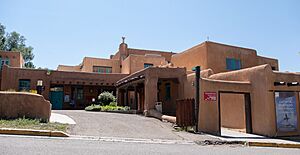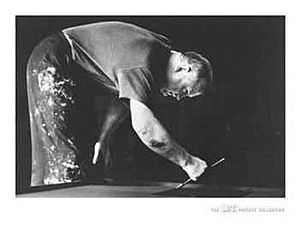Harwood Museum of Art facts for kids
The Harwood Museum of Art is a special place located in Taos, New Mexico. It was started in 1923 by the Harwood Foundation, making it the second oldest art museum in New Mexico. The museum has many different types of art. These include Hispanic art, works from the Taos Society of Artists, art by the Taos Moderns, and art by artists from today. In 1935, the University of New Mexico bought the museum. Since then, the museum has grown to include a large hall for events, a library, and more rooms to show art.
Contents
Art Collections at Harwood Museum
The Harwood Museum of Art in Taos has a permanent collection of over 1,700 pieces of art. It also has 17,000 photographic images. The art ranges from the 1800s to today. It shows the many different cultures and ideas that have shaped the Taos art community. The main types of art you can see are: Hispanic art, works by the Taos Society of Artists, art by the Taos Moderns, contemporary art, and prints, drawings, and photographs.
Hispanic Art Collection
The Harwood Museum has a large collection of Hispanic art. This includes paintings, tinware, and woodworking. These pieces show the amazing skills that have been passed down since the Spanish people first came to New Mexico.
Woodworking Art
In the late 1700s and early 1800s, it was too costly to ship furniture from Mexico City. So, people in New Mexico started their own carpentry shops. They made beautiful carved furniture. This included cajas (storage chests), harineros (grain chests), and trasteros (kitchen cupboards). The Valdez workshop in Taos County made pieces with special carved asterisk marks. Some of these works were painted in bright red and blue colors.
Tin Work Art
Tin work was a very important part of Hispanic religious culture in the 1800s. Artists used tin cans, glass panes, and religious pictures to create special religious objects. There were 13 workshops in New Mexico that made tin art between 1840 and 1915. By the early 1900s, tinsmiths mostly made items for homes. These included sconces (wall lights), lanterns, and small trinket boxes.
Santos: Sacred Art
Santos are sacred images used in Roman Catholic homes and churches. They have been made in New Mexico since the late 1700s. The museum has santos donated by Mabel Dodge Luhan that were made between 1800 and 1850. It also has newer works. The Harwood has the largest public collection of non-religious works by Patrociño Barela (1900–1964). He was a famous leader for modern santeros (artists who make santos). Some of his carvings in the museum were even shown at the Museum of Modern Art in New York.
Spanish Colonial Revival Art
In the 1920s and 1930s, there was a style called Spanish Colonial revival. This style appeared in many art forms. It included furniture, tinware, buildings, and colcha embroidery (a type of needlework). The government and private groups helped fund programs. These programs hired teachers to teach these traditional crafts. The New Deal program in Taos had a crafts school for tin work and furniture. This school created pieces like tin chandeliers, armarios (cabinets), bancos (benches), mesas (tables), and sillas (chairs). Some of these pieces are still used in the Harwood Museum's galleries and offices today.
Taos Society of Artists
The Taos Society of Artists was formed in 1915. These artists were inspired by the Taos Pueblo people and the beautiful Taos landscape. The group included European-trained artists like Joseph Henry Sharp, Bert Geer Phillips, Ernest L. Blumenschein, Oscar E. Berninghaus, E. Irving Couse, and W. Herbert Dunton. They wanted an organization similar to the Barbizon School of artists in France.
The Taos Society of Artists organized traveling shows of their members' works across the United States. Their art often showed Native Americans, Hispanics, and early Anglo-American settlers. They also painted many landscapes. The group stopped working together in 1927.
Taos Moderns: A New Style
In the 1940s, a new group of artists came to Taos. Some of them were able to study art thanks to the G.I. bill. They brought ideas from European and American modern art. These artists came from places like New York City and San Francisco. These cities were important centers for abstract art after World War II. By the 1950s, Taos had become one of the main places for modern art in the country. These artists became known as the "Taos Moderns."
Andrew Dasburg came to Taos and helped many of these new artists. Some of the artists who became famous during this time include Thomas Benrimo, Agnes Martin, Clay Spohn, and Edward Corbett. Other famous artists who visited Taos were Richard Diebenkorn, Mark Rothko, Ad Reinhardt, Clyff Still, and Morris Graves.
Like the earlier artists, the Taos Moderns showed the colorful New Mexican landscape and its cultures. They were inspired by the "timelessness they saw in Puebloan culture." They also noticed the deep connection to the land that both Native Americans and Hispanics had. This inspired them to try new things in their own art. Instead of just painting realistic pictures, they wanted to capture the true meaning of their subjects.
Contemporary Art Today
The 1960s and 1970s were a time of change for the Taos art colony. Some of the important leaders of the art community passed away. These included Mabel Dodge Luhan, Andrew Dasburg, Emil Bisttram, and Dorothy Brett. A new group of artists also arrived when Dennis Hopper came to Taos. He was there to finish editing his movie "... Rider." He ended up staying and bought the Mabel Dodge Luhan property. Like Mabel, he encouraged artists, musicians, and famous people to visit him in Taos.
Many contemporary artists came to Taos. These included Ronald Davis, Dennis Hopper, Kenneth Price, Larry Bell, Ron Cooper, Gus Foster, Lee Mullican, Larry Calcagno, and R. C. Gorman. Some of them moved to Taos for good, while others spent part of each year there.
Kenneth Price's project called "Happy's Curios" was shown at the Los Angeles County Museum of Art. The Harwood Museum has one of the larger pieces from that collection, "Death Shrine 1," on a long-term loan. The Harwood's collection also includes a show of 18-20 works by Larry Calcagno and R. C. Ellis. Taos is a second home for artists from both the east and west coasts. This helps Taos keep its international reputation as an art center.
In 2009, the Harwood Museum held a group art show. It was put together by Dennis Hopper and was called Hopper Curates - Larry Bell, Ron Cooper, Ronald Davis, Kenneth Price & Robert Dean Stockwell.
Prints, Drawings, and Photographs
The Harwood Museum of Art shows works from its permanent collection of prints, drawings, and photographs. It also displays works that are on loan. The museum's collection includes works by early artists like Howard Cook, Joseph Imhoff, Gene Kloss, Nicolai Fechin, and Walter Ufer. Joseph Imhoff was the first to bring a lithography press to Taos.
The works of Tom Benrimo, Andrew Dasburg, Earl Stroh, and Louis Leon Ribak represent the Taos Moderns. The collection also has prints and drawings from more recent artists. These include Larry Calcagno, R.C. Ellis, Kenneth Price, Joe Waldrum, Vija Celmins, Wes Mills, and Bill Gersh.
The collection also has more than 17,000 photographic images. These pictures show Taos art and artists, Hispanic villages, and Indian Pueblos.
Museum History
Burt and Elizabeth Harwood left their home in France in 1916. They moved to Taos and bought a group of small adobe buildings on Ledoux Street. For the next three years, Burt Harwood managed the remodeling of the buildings. He made sure they fit the local building styles. He named the whole place "El Pueblito," which means "The Little Village."
The Harwoods soon realized there was no public library in Taos. So, they opened their own large private library to everyone. Mabel Dodge Luhan helped them by donating books and money. The Harwood often showed art like pottery, textiles, wood sculptures, and santos. The museum, which started in 1923, is the second oldest art museum in New Mexico.
In 1929, the University of New Mexico opened an art school at the Harwood. The Harwood Foundation was given to the University of New Mexico in 1935. It then became a place for university programs in Taos County, New Mexico. In 1937, the museum was expanded. The famous architect John Gaw Meem designed the new parts. These included an auditorium, a stage, more exhibition space, and a larger library.
In 1997, the Harwood Museum opened after another big renovation and expansion. This included the Agnes Martin Gallery. This gallery was built to hold seven paintings that the artist donated to the museum. The museum director, Robert M. Ellis, was a close friend of Agnes Martin. He helped arrange the gift of the paintings and the design of the special octagonal (eight-sided) gallery space. The design followed the artist's specific ideas and was done by an architectural firm from Albuquerque. The Agnes Martin Gallery brings visitors from all over the world. Experts have compared it to famous chapels like the Chapelle du Rosaire de Vence (Matisse Chapel), Corbusier's Chapel of Notre Dame du Haut in Ronchamp, and the Rothko Chapel in Houston.
See also





